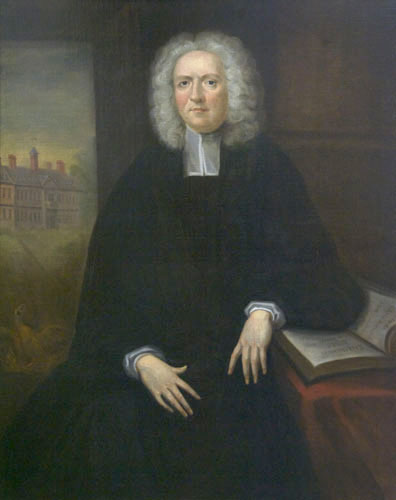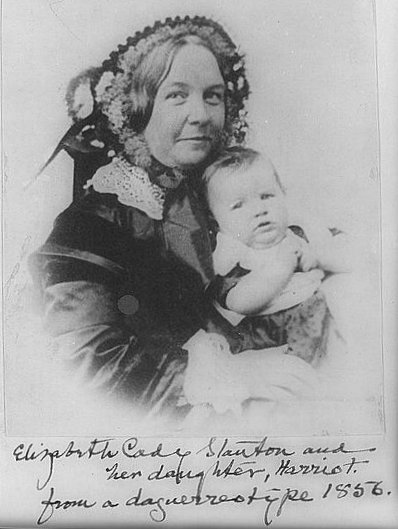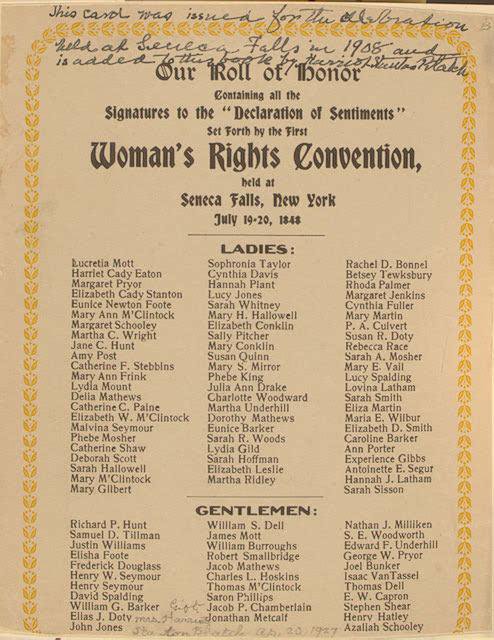|
Thomas M'Clintock
Thomas M'Clintock (March 28, 1792 – March 19, 1876) was an American pharmacist and a leading Quaker organizer for many reforms, including abolishing slavery, achieving women's rights, and modernizing Quakerism. Life He was born on March 28, 1792 in Delaware, the son of Thomas and Mary Allen M'Clintock. Thomas's father was a Presbyterian, and his mother a Quaker, although their marriage resulted in her being removed from the Quaker rolls for marrying out of meeting. Thomas became a druggist or pharmacist, which at the time would have been achieved through an apprenticeship. Thomas became a Quaker by commitment in 1811. At age twenty-two, Thomas began working as a druggist, opening his own store in Philadelphia, and six years later, in 1820, he married Mary Ann Wilson in Burlington, New Jersey. They began their life together in Philadelphia, where they lived for the first seventeen years of their marriage, and where Thomas M'Clintock began his involvement in abolitionis ... [...More Info...] [...Related Items...] OR: [Wikipedia] [Google] [Baidu] |
Brandywine Hundred, Delaware
Brandywine Hundred (also known as North Wilmington) is an unincorporated subdivision of New Castle County, Delaware. It is located to the north and northeast of the city of Wilmington. Hundreds were once used as a basis for representation in the Delaware General Assembly. Brandywine Hundred and North Wilmington are commonly used colloquial names for this area. However, while their names still appear on all real estate transactions, all other hundreds in Delaware presently have no meaningful use or purpose except as a geographical point of reference. In the 2010 census, Brandywine had 77,182 people. Grubb's Landing Brandywine Hundred, also known as Grubb's Landing, was settled by two sons of John Grubb (1652–1708): Emanuel Grubb and John Grubb II (1684–1757). Boundaries and formation Brandywine Hundred is that portion of New Castle County that lies north of the Christina River and east of Brandywine Creek, excepting that portion in the south included in Wilmington ... [...More Info...] [...Related Items...] OR: [Wikipedia] [Google] [Baidu] |
Free Produce Movement
The free-produce movement was an international boycott of goods produced by slave labor. It was used by the abolitionist movement as a non-violent way for individuals, including the disenfranchised, to fight slavery. In this context, ''free'' signifies "not enslaved" (i.e. "having the legal and political rights of a citizen"). It does not mean " without cost". Similarly, "produce" does not mean just fruits and vegetables, but a wide variety of products made by slaves, including clothing, dry goods, shoes, soaps, ice cream, and candy. 1700s The concept originated among members of the Religious Society of Friends (Quakers), in the late 18th century. Quakers believed in pacifism and in the spiritual equality of all humankind. Quakers opposed slavery, and by about 1790 had eliminated slaveholding from among their membership. Radical Quakers such as Anthony Benezet and John Woolman went further, voicing their opinion that purchasers of slave-derived goods were guilty of keeping the ... [...More Info...] [...Related Items...] OR: [Wikipedia] [Google] [Baidu] |
College Of William And Mary
The College of William & Mary (officially The College of William and Mary in Virginia, abbreviated as William & Mary, W&M) is a public research university in Williamsburg, Virginia. Founded in 1693 by letters patent issued by King William III and Queen Mary II, it is the second-oldest institution of higher education in the United States and the ninth-oldest in the English-speaking world. Institutional rankings have placed it among the best public universities in the United States. The college educated American presidents Thomas Jefferson, James Monroe, and John Tyler. It also educated other key figures pivotal to the development of the United States, including the first President of the Continental Congress Peyton Randolph, the first U.S. Attorney General Edmund Randolph, the fourth U.S. Supreme Court Chief Justice John Marshall, Speaker of the House of Representatives Henry Clay, Commanding General of the U.S. Army Winfield Scott, sixteen members of the Continental Congr ... [...More Info...] [...Related Items...] OR: [Wikipedia] [Google] [Baidu] |
Women's Rights National Historical Park
Women's Rights National Historical Park was established in 1980, and covers a total of of land in Seneca Falls and nearby Waterloo, New York, United States. The park consists of four major historical properties including the Wesleyan Methodist Church, which was the site of the 1848 Seneca Falls Convention, the first women's rights convention. The Elizabeth Cady Stanton House, and the homes of other early women's rights activists (the M'Clintock House and the Richard Hunt House) are also on display. The park includes a visitor center and an education and cultural center housing the Suffrage Press Printshop. The Visitor Center lobby houses a large, life-size bronze sculpture, ''The First Wave'', which consists of twenty figures representing women and men who attended the first Women's Rights Convention. Nine of the sculpture's figures represent actual participants and organizers of the convention: Elizabeth Cady Stanton, Lucretia Mott, Mary Ann M'Clintock, Martha Wright, Jan ... [...More Info...] [...Related Items...] OR: [Wikipedia] [Google] [Baidu] |
List Of Suffragists And Suffragettes
This list of suffragists and suffragettes includes noted individuals active in the worldwide women's suffrage movement who have campaigned or strongly advocated for women's suffrage, the organisations which they formed or joined, and the publications which publicized – and, in some nations, continue to publicize – their goals. Suffragists and suffragettes, often members of different groups and societies, used or use differing tactics. "Suffragette" in the British usage denotes a more " militant" type of campaigner, while suffragettes in the United States organized such nonviolent events as the Suffrage Hikes, the Woman Suffrage Procession of 1913, and the Silent Sentinels. Argentina *Cecilia Grierson (1859–1934) – the first woman physician in Argentina; supporter of women's emancipation, including suffrage *Julieta Lanteri (1873–1932) – physician, freethinker, and activist; the first woman to vote in Argentina *Alicia Moreau de Justo (1885–198 ... [...More Info...] [...Related Items...] OR: [Wikipedia] [Google] [Baidu] |
M'Clintock House
M'Clintock House, also known as the Baptist Parsonage, is a historic home located at Waterloo in Seneca County, New York. It is a two-story, Federal style brick dwelling built in 1833–1836. The home is notable as the residence of Quaker pharmacist Thomas M'Clintock and his wife Mary Ann from 1836 to 1856. On July 16, 1848, the home was the location where the Declaration of Sentiments, resolutions, and speeches were drawn up for the subsequent First Women's Rights Convention. It was listed on the National Register of Historic Places in 1980. The house is one of the sites of the Women's Rights National Historical Park. The restored mid-19th century home is open for tours in the summer. See also *List of monuments and memorials to women's suffrage *Votes For Women History Trail *Timeline of women's suffrage *Women's suffrage in the United States In the 1700's to early 1800's New Jersey did allow Women the right to vote before the passing of the 19th Amendment, but in ... [...More Info...] [...Related Items...] OR: [Wikipedia] [Google] [Baidu] |
National Register Of Historic Places
The National Register of Historic Places (NRHP) is the United States federal government's official list of districts, sites, buildings, structures and objects deemed worthy of preservation for their historical significance or "great artistic value". A property listed in the National Register, or located within a National Register Historic District, may qualify for tax incentives derived from the total value of expenses incurred in preserving the property. The passage of the National Historic Preservation Act (NHPA) in 1966 established the National Register and the process for adding properties to it. Of the more than one and a half million properties on the National Register, 95,000 are listed individually. The remainder are contributing resources within historic districts. For most of its history, the National Register has been administered by the National Park Service (NPS), an agency within the U.S. Department of the Interior. Its goals are to help property owners and inte ... [...More Info...] [...Related Items...] OR: [Wikipedia] [Google] [Baidu] |
Waterloo, New York
Waterloo is a town in Seneca County, New York, United States. The population was 7,338 at the 2020 census. The town and its major community are named after Waterloo, Belgium, where Napoleon was defeated. There is also a village called Waterloo, the primary county seat of Seneca County. The Town of Waterloo is situated on the western border of the county, east of Geneva. History The area was the domain of the Seneca tribe and Cayuga tribe, who were visited in the 17th Century by Jesuit missionaries. The Sullivan Expedition passed through the area in 1779 to destroy the natives and their villages. After the war, the area was in the Central New York Military Tract, reserved for veterans. The region was first settled ''circa'' 1800. The town was formed from the Town of Junius in 1829. Geography According to the United States Census Bureau, the town has a total area of 21.8 square miles (56.5 km2), of which 21.7 square miles (56.2 km2) is land and ... [...More Info...] [...Related Items...] OR: [Wikipedia] [Google] [Baidu] |
Rochester, New York
Rochester () is a City (New York), city in the U.S. state of New York (state), New York, the county seat, seat of Monroe County, New York, Monroe County, and the fourth-most populous in the state after New York City, Buffalo, New York, Buffalo, and Yonkers, New York, Yonkers, with a population of 211,328 at the 2020 United States census. Located in Western New York, the city of Rochester forms the core of a larger Rochester metropolitan area, New York, metropolitan area with a population of 1 million people, across six counties. The city was one of the United States' first boomtowns, initially due to the fertile Genesee River Valley, which gave rise to numerous flour mills, and then as a manufacturing center, which spurred further rapid population growth. Rochester rose to prominence as the birthplace and home of some of America's most iconic companies, in particular Eastman Kodak, Xerox, and Bausch & Lomb (along with Wegmans, Gannett, Paychex, Western Union, French's, Cons ... [...More Info...] [...Related Items...] OR: [Wikipedia] [Google] [Baidu] |
Rochester Women's Rights Convention Of 1848
The Rochester Women's Rights Convention of 1848 met on August 2, 1848 in Rochester, New York. Many of its organizers had participated in the Seneca Falls Convention, the first women's rights convention, two weeks earlier in Seneca Falls, a smaller town not far away. The Rochester convention elected Abigail Bush as its presiding officer, making it the first U.S. public meeting composed of both sexes to be presided by a woman. This controversial step was opposed even by some of the meeting's leading participants. The convention approved the Declaration of Sentiments that had first been introduced at the Seneca Falls Convention, including the controversial call for women's right to vote. It also discussed the rights of working women and took steps that led to the formation of a local organization to support those rights. Many of the organizers of the convention were part of a group of Quaker dissidents who had begun to associate with the First Unitarian Church of Rochester, the si ... [...More Info...] [...Related Items...] OR: [Wikipedia] [Google] [Baidu] |
Elizabeth Cady Stanton
Elizabeth Cady Stanton (November 12, 1815 – October 26, 1902) was an American writer and activist who was a leader of the women's rights movement in the U.S. during the mid- to late-19th century. She was the main force behind the 1848 Seneca Falls Convention, the first convention to be called for the sole purpose of discussing women's rights, and was the primary author of its Declaration of Sentiments. Her demand for women's right to vote generated a controversy at the convention but quickly became a central tenet of the women's movement. She was also active in other social reform activities, especially abolitionism. In 1851, she met Susan B. Anthony and formed a decades-long partnership that was crucial to the development of the women's rights movement. During the American Civil War, they established the Women's Loyal National League to campaign for the abolition of slavery, and they led it in the largest petition drive in U.S. history up to that time. They started a newspape ... [...More Info...] [...Related Items...] OR: [Wikipedia] [Google] [Baidu] |
Declaration Of Sentiments
The Declaration of Sentiments, also known as the Declaration of Rights and Sentiments, is a document signed in 1848 by 68 women and 32 men—100 out of some 300 attendees at the first women's rights convention to be organized by women. Held in Seneca Falls, New York, the convention is now known as the Seneca Falls Convention. The principal author of the Declaration was Elizabeth Cady Stanton, who modeled it upon the United States Declaration of Independence. She was a key organizer of the convention along with Lucretia Coffin Mott, and Martha Coffin Wright. According to the ''North Star,'' published by Frederick Douglass, whose attendance at the convention and support of the Declaration helped pass the resolutions put forward, the document was the "grand movement for attaining the civil, social, political, and religious rights of women." Background Early Activism and the Reform Movements In the early 1800s, women were largely relegated to domestic roles as mothers and homema ... [...More Info...] [...Related Items...] OR: [Wikipedia] [Google] [Baidu] |


.jpg)



